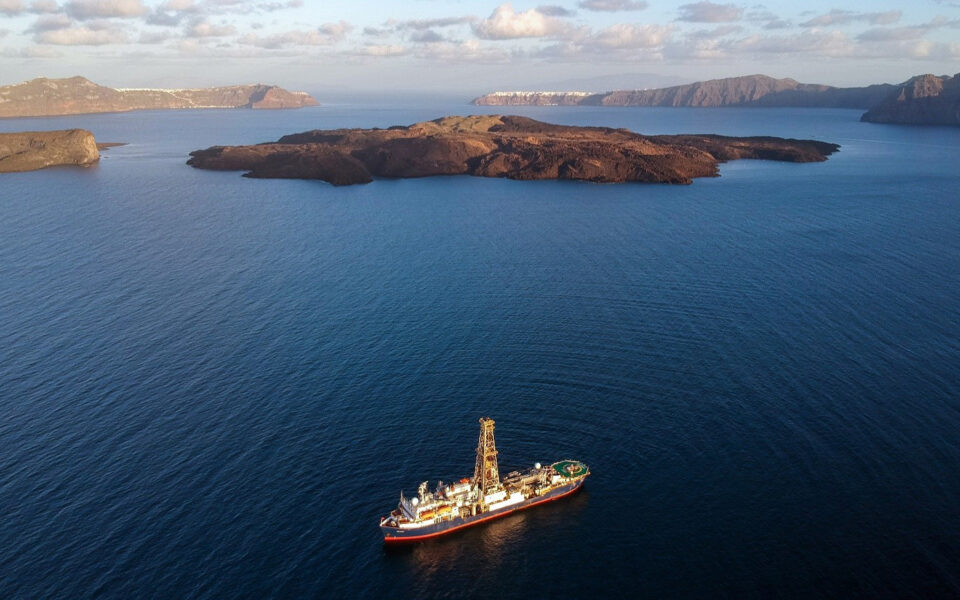
An international team of scientists has discovered that a 726 AD eruption of the Santorini volcano was a lot bigger than initially estimated, suggesting explosive blasts can occur even in periods of relative quiet.
Published in the Nature Geoscience journal on Monday, the study’s findings change “the prevailing view that Kameni Volcano has been in a predominately effusive state since the Minoan eruption and implies that the Santorini volcanic system has been capable of producing highly explosive eruptions in its current early stage in the caldera cycle,” the paper says.
The team’s analysis, based on drilling carried out as part of the International Ocean Discovery Program (IODP) Expedition 398, found that the magnitude of the 726 AD eruption was greater than assumed and that pumice from the blast may have traveled all the way to the coast of Asia Minor.
“Historical accounts mention that, during the summer of 726 CE, the sea within the Santorini caldera began to boil until dense smoke rose and was accompanied by pyroclastic eruptions,” researchers wrote in the study.
According to the team, “Large pumice blocks were ejected in such quantity that they covered the sea over an immense area, reaching the coasts of Macedonia and Asia Minor more than 400 km [kilometers, or 250 miles] away.”
“Our results demonstrate that Kameni Volcano has been capable of producing a major VEI 5 explosive eruption in the recent past,” the paper argues. “This changes the prevailing view that Kameni Volcano has been in a predominately effusive state since the Minoan eruption and implies that the Santorini volcanic system has been capable of producing highly explosive eruptions in its current early stage in the caldera cycle.”
“A similar eruptive event today would have severe consequences not only for the inhabitants of Santorini and its neighboring islands but also for the broader eastern Mediterranean,” it was said.
“Eruption phenomena may include tsunamis generated by submarine explosions, extensive pumice rafts and large airborne ash plumes with significant impacts on coastal communities, aviation, maritime transportation and submarine cables,” it was added.
Underwater eruption detected at Santorini volcano
In January, an international scientific team discovered a previously unknown underwater volcano eruption off Santorini. It is believed to be six times larger and 520,000 years older than the Minoan eruption.
The underwater Santorini volcano eruption was one of the largest in the volcanic arc of the southern Aegean. An expedition carried out by the research vessel JOIDES Resolution Science Operator brought the eruption to light. The research program International Ocean Discovery Program maintains and runs the particular vessel.
The team identified a huge pumice, or volcanic rock, deposit. They drew samples from this at seven underwater locations around the island of Santorini.
The results of the study have been published in a subset of Nature, titled Communications Earth & Environment.
The pumice layer, colloquially referred to as “ancient tophos,” points to a shallow underwater eruption of the prehistoric volcano of Santorini that took place around 520,000 years ago. This is with a possible deviation of 10,000 years.
Thin layers of volcanic pumice deposits that were fired from the eruption covered three islands in the area.
The pyroclastic flows discharged under the sea, carried water away and turned into currents of turbidity and mud that covered the seabed up to approximately 45 miles (around 70 km) from their source. This formed a submarine deposit with a volume of more than about 22 cubic miles (90 cubic km) and a thickness of up to 493 feet (150 meters).
This deposit is six times larger than the pyroclastic flow deposits of the great Minoan explosion that occurred during the Late Bronze Age (about 3,600 years ago) and contributed to the decline of the Minoan civilization of Crete.
Related: Growing Magma Under Santorini Volcano a ‘Real Threat’
See all the latest news from Greece and the world at Greekreporter.com. Contact our newsroom to report an update or send your story, photos and videos. Follow GR on Google News and subscribe here to our daily email!



